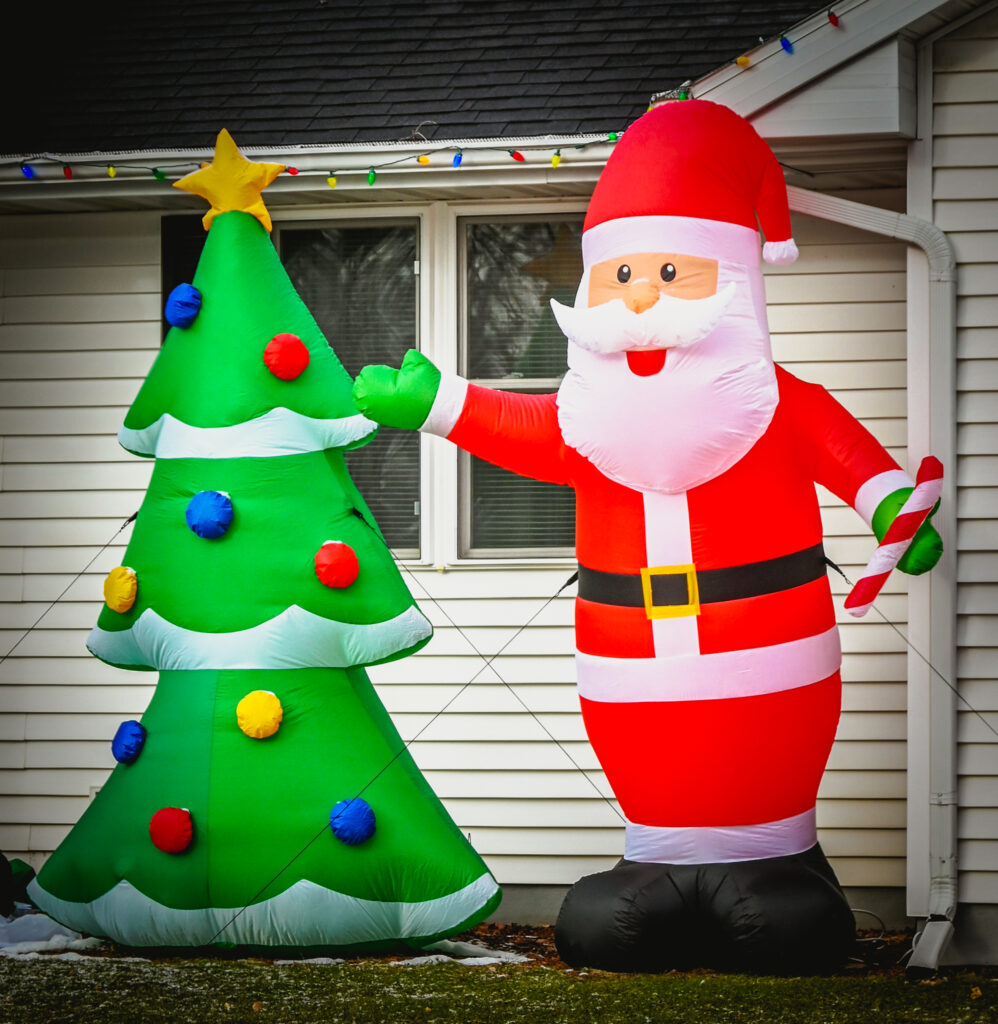Today’s the Day
You’ve made the commitment. Your grass has been begging for some excitement since fall arrived and here it is finally…a ten foot tall holiday inflatable decoration for spectators to gaze in awe at its wonderful size and glory. It’s incredible and yet simple. But, wait a second…how do you stop this giant reindeer from magically flying back to the North Pole when the next big storm hits??

Rudolph with your nose so bright, won’t you stay-put in our yard tonight?
Taking the proper steps to firmly secure your investment only takes a bit of time and sometimes can require an extra part or two that did not come in the box with your inflatable.
We’ve assembled the steps below to help you to pin down even the largest of these polyester characters so that you can feel confident that they will still be right were you left them the next time any heavy wind or rain passes through.
A Few Things First
- Pick a Location. While it may seem like anywhere would be fine for your newest LED backlit Nativity Scene or 6ft tall Menorah, a wide open space is where wind loves to gust right through and this be disastrous if you’re not prepared. Keeping your inflatable near an object like a wall, bush, etc will help to minimize the wind impact and maximize the chances of it staying put. Do keep in mind that due to the size of your inflatable it can sway around quite a bit if left turned on during a storm with heavy winds and rain. It is always recommended to deflate your decoration to reduce the chance of damage from swaying into any close-by objects such as trees or walls.
- Find Level Ground. A flat ground is a happy ground. A level area will assure that your new inflatable stands straight up and does not lean which will in turn help make a more attractive scenery. This will also prevent light winds from knocking over your display and causing possible damage. If you do not have a level area it is recommended to grab a few sandbags and place one or two underneath to turn your existing space to a level space. These can be picked up at most hardware stores, are easily purchased online, or you can fill a regular plastic bag with sand to make one of your own.
- Layout your Parts. It’s time to open the box, remove the contents, and organize them to make sure you know what’s included and if anything might be missing. You should see the inflatable, a power supply, a few strings, lawn stakes, and possibly one or two other items such as plastic clips or even a mounting base.
- Inspect & Identify. This step is best to tackle in a dry space either at the location or inside in a controlled environment so that you can properly get to know your new product. Start by unfolding the inflatable and determine where the bottom is. Do a quick visual inspection of the seams to make sure there is no damage from manufacturing or shipping. Next, locate the tether loops on the very bottom and up in the middle for properly securing, the fan, the power wire port, and the zipper access port near the bottom which is used for letting out air quickly and for access to the internal parts. These are all important parts which require yearly inspection so getting to know them early is very helpful.
- Do a Test Run. We recommend to do this when new and at the start of each season in an effort to stay ahead of any potential problems that might occur as weather can take a toll on these products. Choose a location that is dry, clear of any obstacles, and has the proper height for your giant new decoration to stand tall. Plug in the power cable and allow the product to fill with air while also observing the seams for any possible tears or holes. Once inflated, do a quick walk around and make sure that there is no damage and look for any tether loops that may have been missed. If all looks good, it’s time to deflate (that zipper port comes in handy here) and move it outside to its seasonal display location!
Choose a Securing Technique
- Stake to the Ground (Recommended). Grab a hammer! This is the most secure of all methods and does require about 2-5 feet of space around the inflatable to properly execute.
- Position your inflatable in its display location
- Fill it with air and locate all tether loops
- Place the stakes directly through the lowest tether loops at the bottom of the unit and into the ground to keep the base from moving
- Attach the strings to the tether loops up in the middle which were found during the inspection earlier *See Pro Tip #3 Below
- Loop / tie the string to the stake, sometimes they will include a small plastic lock to assist in properly securing *See Pro Tip #1 Below
- Pull the string outward from the loop and towards the front or back of the inflatable, then towards the grass at a 45 degree angle while keeping tension on the line.
- Hammer in the stake while watching to make sure that tension is always on the inflatable
- Repeat this until complete
- Test deflating to make sure that the inflatable stands back up in the same position for repeated results
- Do a follow up inspection a week or so later to make sure the sand bags are holding up
- Tie to a Nearby Object. Utilizing twine or the fabric rope that comes with an inflatable to tie it to a nearby object such as a fence, post, bush, column, etc is a great way to make sure your investment doesn’t take-off on you especially if there is not enough grass or dirt in the area.
- Position your inflatable in its display location
- Fill it with air and locate all tether loops
- If above dirt or grass, place the stakes directly through the lowest tether loops at the bottom of the unit and into the ground to keep the base from moving *See Pro Tip #2 Below
- Attach the strings to the tether loops up in the middle which were found during the inspection earlier *See Pro Tip #3 Below
- Pull the string taught and slightly downward towards the object that you would like to secure to
- Properly tie and secure it to the nearby object
- Repeat this for each side to keep your decoration properly leveled and standing straight up
- Test deflating to make sure that the inflatable stands back up in the same position for repeated results
- Do a follow up inspection a week or so later to make sure the tethers are holding up
- Utilize Sandbags Internally. One of the least obtrusive and cleanest ways to firmly secure a holiday inflatable is to place sand or stone bags inside of the unit which weigh enough to prevent it from moving. Almost all products out there have a small amount of sand in them from the factory but these alone will not hold them in place while outdoors. You will need to pick up sand or small stones (nothing with sharp edges though!) from a local hardware store or possibly from your yard to complete this method.
- Fill a 3-4 plastic bags with the sand or small stone. The size and weight will vary based on the size of your zipper opening, the size of your inflatable, and can only be determined on a case by case basis which makes this method a bit more challenging than the others.
- Place them inside your inflatable by utilizing the zipper opening in the bottom which was located at the initial inspection
- Inflate and push on the inflatable to make sure that it stays standing and does not move while pushing against it
- If it passes this test it is likely good to go
- Do a follow up inspection a week or so later to make sure the sand bags are holding up
Pro Tips!
Pro Tip #1: Keep in mind that you will need to do this four times and should end up with an “X” pattern if you were to look down from the top straight over the inflatable. Think of it as staking down four invisible corners of the product as this will keep it centered and standing straight up every time you turn it on.
Pro Tip #2: We do recommend picking up a few higher grade metal “X” style stakes that can be hammered into the ground as they are one of the strongest versions out there over the ones typically included, when possible. A strong stake makes for a strong hold on your decoration and while one may or may not be included you may want to invest in a set that you know will withstand strong winds.
There are a few types available:
- Straight metal garden pins – usually this is the type is included with small inflatables
- Metal garden staples – common “U” shaped stakes with smaller units
- Straight plastic “X” type for tents – these are included in mid to large sized inflatables
- Metal spiral stakes – sometimes these are included in larger inflatables and used for the lowest loops on the base
- Heavy Duty Aluminum “X” type – recommended to purchase separately
Pro Tip #3: Black Braided 1.2mm Twine is a great tool to have around for holiday inflatables as well as just about any decorating project for its strength and ability to withstand the weather!
